Expert view: Sean Brennan
- 19 October 2010
 Sean Brennan
Sean Brennan
The world in which we expect to care for our ageing community is very different from the one that welcomed the baby boomers just a few decades ago. The focus is now on caring for an increasing number of patients and/or clients in their own homes.
The big question is: can the staff who care for these patients be supported by technology? And the answer is: yes. There are many ways that technology can be used in this environment, starting with teleconferencing or tele-visiting, and moving onto monitoring vital signs remotely.
Supporting community clinicians
There should be an underlying philosophy when it comes to the use of technology in a clinical space. “It should support the clinicians and carers in what they do.”
So, there is no single, homogenous group of staff called ‘community clinical staff’. Some are employed by, and work from, the GP practice. Others are employed and based in the primary care trust (or whatever will soon replace it). Others are employed and based in the local hospital.
Some collect reams and reams of textual information. Others simply update a care plan with a tick. So there is no one single solution for this heterogeneous workforce and what works for one may be overkill for the other.
However, one thing these staff have in common is that they are all mobile –they go to the patient. The patient doesn’t come to them.
This means that the clinical application that supports them should be appropriate for that mobility. Simply giving all these community staff a wireless laptop and access to the all-singing, all-dancing clinical system may not always be the answer. There may be a better way.
In order to appreciate the current issues and examine alternatives, a number of scenarios were described in a fuller version of this paper (see www.eprarms.com).
The Future?
For now, though, let’s imagine one scenario:
Nurse Jones picks up her iPhone from its recharging cradle at the front door (other PDAs are available.)
Her case-list for the day: Albert; Ethel then Nellie.
Albert is just round the corner from where she lives. She would logically have gone to Nellie next as she is only two miles down the road, but Nellie has a podiatry appointment in town so she has requested a late morning visit. The system acknowledged this in the schedule.
Nurse Jones picks up her bag. Pocketing the iPhone, she reflects on the days when she had to carry a bag with a lap-top, a separate sat nav and a (work) mobile phone about with her.
“Use your lap-top in between visits in your car” the IM&T guy once told her.
“In Huddersfield?” she’d said to him. “You are joking!”
“Well, in the patient’s house then.”
“Tried that. No thanks! I couldn’t get logged in.”
Nurse Jones brings up her community record work app, opens the day’s appointments page and clicks on ‘Albert’. “Turn left at the end of the road” says Gladis (the Geographic Location Information and Direction System).
Once she has arrived at Albert’s address, she clicks ‘Arrived’ and opens up Albert’s specific templates in his clinical record. She is reminded that to get into Albert‘s house, she needs to use the key in the key safe.
She lets herself in and checks on Albert.
She updates the records while talking to him. ADL’s done at the click of a finger. Most of the descriptive text is canned and as soon as she types some keywords, blocks of text are made available to her.
The size of the PDA does not cause a barrier between her and Albert and she presses ‘Send’ at the end of the visit to save the update to the server.
She writes in Albert’s paper note that she has been and summarises what she did, although the trust is looking at giving her a portable printer so she can print out a summary to update the mantle-piece record or use a digital pen to write in the paper mantle-piece record and upload it into the PDA.
Anything’s better than sitting in a dark car on a cold November night with the eerie glow of the lap-top attracting the yobs like moths.
Next. Ethel. Nurse Jones clicks on ‘Ethel’. “Turn right at the bottom of Haymakers drive” says Gladis. ETA 11.23 am.
And so it goes on. After Nellie, Nurse Jones goes home for lunch. Her rounds are done. Her mileage calculated. Her time spent on face to face ‘liaisons’ recorded for her.
This approach is a different one. It is not about simply making the very good clinical community system available to a mobile workforce. It is about re-thinking what data is needed and how can it be captured easily as a by-product of the delivery of clinical care.
It is not about collecting data – it is about making the work of these mobile community staff safer and easier and more effective.
It is worth restating that some staff collect so much information that this PDA solution would not be appropriate. For them, the wireless laptop solution in the patient’s home may be the only option. But for those who do not collect reams of information, this alternative approach is worth considering.
About the author: Sean Brennan got into healthcare IT from a professional career in pathology and then clinical audit, where he realised that without good quality and timely clinical information, clinical audit was impossible.
In 2002, he launched Clinical Matrix Limited, and in 2005, he published a book: ‘The NHS IT Project. The Biggest Computer Programme in the World. Ever!’ More recently, he has been involved in a number of projects in Scotland, where he is currently project manager for the extension of the use of the Emergency Care Summary record in planned care.




